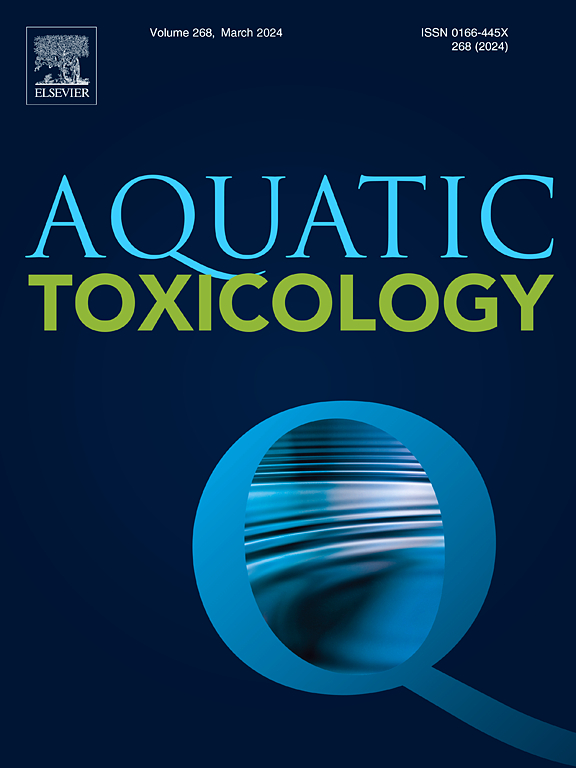红树林鳉鱼幼体接触草甘膦的持续影响
IF 4.1
2区 环境科学与生态学
Q1 MARINE & FRESHWATER BIOLOGY
引用次数: 0
摘要
草甘膦是许多除草剂的主要成分,由于农业径流的原因,水生系统中草甘膦的含量越来越高。由于草甘膦是一种内分泌干扰物,能够干扰生物的生理过程,因此高剂量的草甘膦会导致生物体出现缺陷。我们利用红树林鳉鱼(Kryptolebias marmoratus)来评估幼虫接触草甘膦对水生环境中非目标物种的影响。这些鱼类产生的后代基因完全相同,因此我们可以在控制遗传因素的同时评估表型对毒物暴露的反应。我们用草甘膦的低浓度和高浓度(对照(0 毫克/升)、低浓度(0.01 毫克/升)和高浓度(1.1 毫克/升))处理刚孵化的幼虫 96 小时,然后在 60 天和 130 天时测量其行为、形态和生殖特征。我们预测,这些两栖鱼类暴露于与环境相关的低剂量时,会表现出适应性出水行为,以逃避劣质水质条件,而草甘膦剂量越高,其他性状的缺陷就越大。我们发现,低剂量(0.01 毫克/升)草甘膦会导致焦虑降低(滞后性降低)和跳跃行为受损,而高剂量草甘膦会导致活动降低和平均单个产卵量降低。无论草甘膦的剂量是低还是高,这些影响似乎都不具有适应性。虽然生殖输出的缺陷随剂量的增加而增加,但表型效应通常是针对每种性状的特定剂量。这项研究表明,即使是环境相关浓度的除草剂也可能对水生生物有害,其后果会持续到成年期。此外,鉴于环境相关浓度的草甘膦会诱发生殖输出缺陷,这表明自然系统中的草甘膦污染可能会对种群产生影响。本文章由计算机程序翻译,如有差异,请以英文原文为准。
Persistent effects of larval exposure to glyphosate in mangrove rivulus fish
Glyphosate, a key ingredient in many herbicides, is increasingly present in aquatic systems due to agricultural runoff. High doses of glyphosate cause defects in organisms due to its ability to interfere with physiological processes as an endocrine disruptor. We used the mangrove rivulus fish (Kryptolebias marmoratus) to evaluate the effects of larval exposure to glyphosate on non-target species in aquatic environments. These fish produce genetically identical offspring, allowing us to evaluate phenotypic responses to toxicant exposure while controlling for genetics. We treated newly hatched larvae for 96 h with concentrations of glyphosate on the low and high end of what they would experience in the wild: control (0 mg/L), low (0.01 mg/L), and high (1.1 mg/L), and then measured behavior, morphology, and reproductive traits at 60 and 130 days. We predicted that these amphibious fish exposed to low, environmentally relevant doses would show adaptive emersion behavior to escape poor quality water conditions, and deficits in other traits would be greater with higher glyphosate dosages. We found that low doses (0.01 mg/L) of glyphosate led to lower anxiety (decreased thigmotaxis) and impaired jumping behaviors while high dose exposures to glyphosate resulted in lower activity and lower average egg yield per individual. None of these effects appeared to be adaptive at low or high doses of glyphosate. While deficits in reproductive output scaled with dosage, phenotypic effects were often dosage-specific for each trait. This study demonstrates that even environmentally relevant concentrations of herbicide may be harmful to aquatic organisms and have consequences that persist well into adulthood. Furthermore, given that environmentally relevant concentrations of glyphosate induced deficits in reproductive output, this suggests that glyphosate contamination in natural systems may have population level consequences.
求助全文
通过发布文献求助,成功后即可免费获取论文全文。
去求助
来源期刊

Aquatic Toxicology
环境科学-毒理学
CiteScore
7.10
自引率
4.40%
发文量
250
审稿时长
56 days
期刊介绍:
Aquatic Toxicology publishes significant contributions that increase the understanding of the impact of harmful substances (including natural and synthetic chemicals) on aquatic organisms and ecosystems.
Aquatic Toxicology considers both laboratory and field studies with a focus on marine/ freshwater environments. We strive to attract high quality original scientific papers, critical reviews and expert opinion papers in the following areas: Effects of harmful substances on molecular, cellular, sub-organismal, organismal, population, community, and ecosystem level; Toxic Mechanisms; Genetic disturbances, transgenerational effects, behavioral and adaptive responses; Impacts of harmful substances on structure, function of and services provided by aquatic ecosystems; Mixture toxicity assessment; Statistical approaches to predict exposure to and hazards of contaminants
The journal also considers manuscripts in other areas, such as the development of innovative concepts, approaches, and methodologies, which promote the wider application of toxicological datasets to the protection of aquatic environments and inform ecological risk assessments and decision making by relevant authorities.
 求助内容:
求助内容: 应助结果提醒方式:
应助结果提醒方式:


